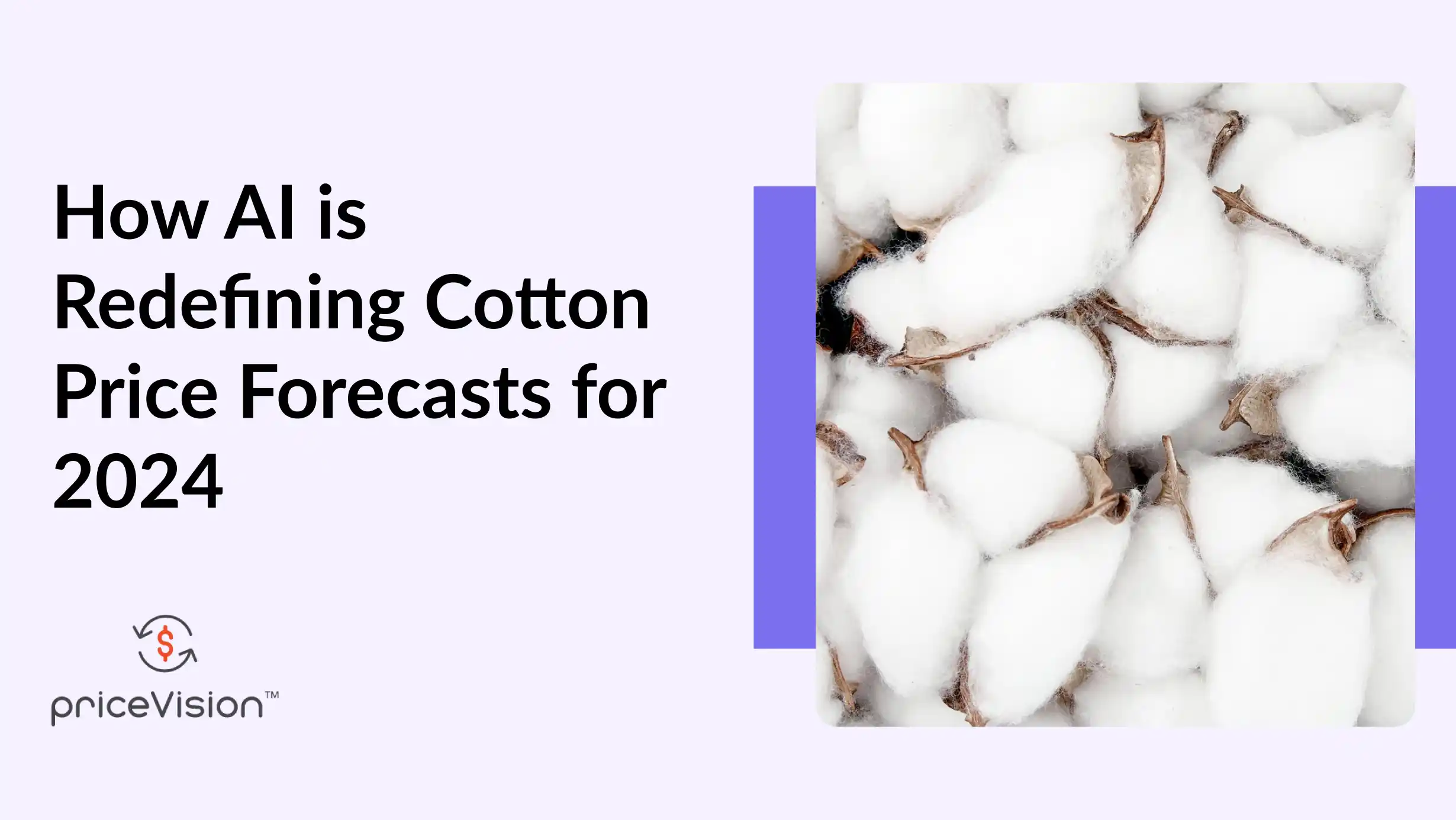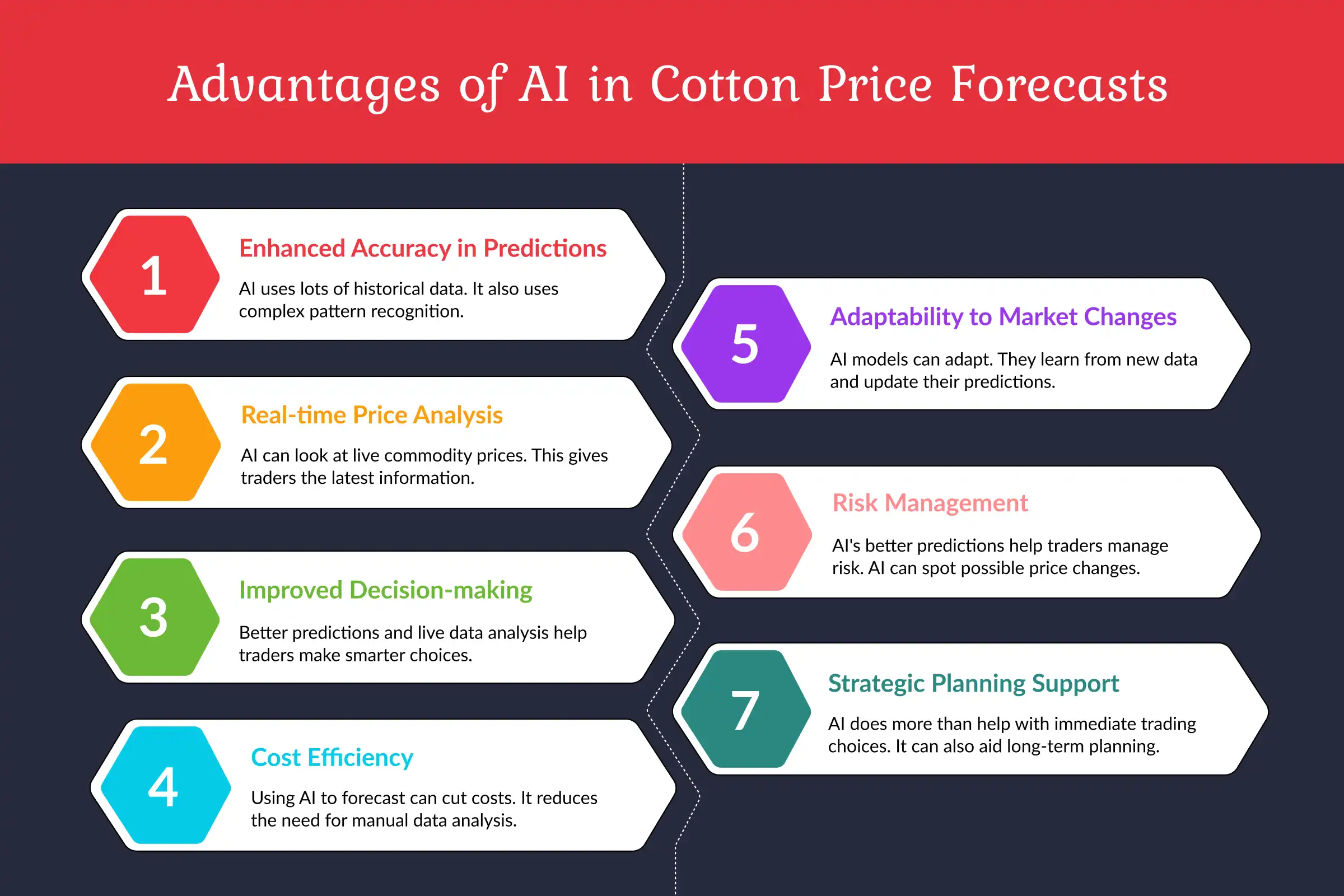How AI is Redefining Cotton Price Forecasts for 2024

The agricultural commodities market is changing quickly. The accuracy of cotton price predictions is very important for people involved worldwide. Entering 2024, Artificial Intelligence (AI) becomes key. It changes how we predict cotton prices, even on big platforms like the Multi Commodity Exchange(MCX). This detailed article looks at AI's role in improving cotton price forecasts. It examines its effect on the live agricultural commodity market. The focus is on providing insights into commodity prices, with a special emphasis on live commodity prices.
What are Cotton Price Forecasts?
Cotton stands out as a major agricultural product. Its price changes due to many reasons. These reasons range from changes in weather to shifts in worldwide demand. In this complex market, accurate predictions of cotton prices are very important. They give farmers, traders, and investors a competitive advantage.
Cotton's price on markets such as ICE Cotton shows the impact of different global factors. Weather, production amounts, and demand in the market are some of these factors. Together, they influence cotton's market price.
How have Forecasting Methods evolved?
The approach to predicting the future in agriculture has changed greatly. It has moved from old methods to new, tech-based ones. This change has been significant in the way market forecasts are made, especially for crops like cotton.
Early Stages: Historical Data and Econometric Models
In the beginning, forecasts depended on past data. Analysts used old trends to guess future ones. They made econometric models. These models used statistics to see how different factors like supply and demand affected prices. However, these methods couldn't adjust to sudden market changes.
Incorporation of External Factors
Later, forecasters added more factors like weather and geopolitics. These greatly affect agriculture markets. But, adding these factors by hand was slow and often inaccurate.
Advent of Computer-Assisted Analysis
Then came computers. They helped analyze data faster and build better models. Forecasters could now use more data for better predictions. Still, humans had to do a lot of the work.
Breakthrough with AI and Machine Learning
The big change came with AI and machine learning. These can look at a lot of data quickly. This includes satellite images and social media. AI can find patterns that people might not see. This has made predictions much better.
Real-time Data Analysis and Predictive Analytics
AI's big plus is working with live data. This is key in the fast-changing agriculture market. Machine learning gets better as it gets more data. This means forecasts can keep up with market changes.
Integration of IoT and Blockchain Technology
Now, we're using IoT and blockchain. IoT devices collect data straight from farms. Blockchain makes sure this data is correct. Using AI with these gives a full market view. This makes forecasts even more accurate.
AI for Predicting Cotton Prices
AI utilizes a comprehensive approach to forecast cotton prices, incorporating machine learning algorithms that process vast datasets, ensuring a more accurate analysis of future price movements.
Advantages of AI in Cotton Price Forecasts
The introduction of Artificial Intelligence (AI) into forecasting has changed many industries. This is especially true for those relying on the trade of commodities, like cotton. AI technology brings many benefits. These benefits improve how commodities are traded by making processes more efficient, accurate, and strategic. Now, we will explore the major advantages of using AI in forecasting. Our focus is on its use in predicting and analyzing cotton prices.

1) Enhanced Accuracy in Predictions
AI uses lots of historical data. It also uses complex pattern recognition. This lets AI predict commodity prices with greater accuracy than old methods. Machine learning sees subtle trends and links. These might be missed by humans. This means forecasts of future prices, including cotton, are more reliable.
2) Real-time Price Analysis
AI can look at live commodity prices. This gives traders the latest information. In markets that change fast, this is very important. Prices can go up or down quickly. Having the latest analysis helps traders make fast, informed choices.
3) Improved Decision-making
Better predictions and live data analysis help traders make smarter choices. They can understand risks better and plan their buying and selling more strategically. They can also spot new trends early. This gives them an advantage in the market.
4) Cost Efficiency
Using AI to forecast can cut costs. It reduces the need for manual data analysis and the chance of losses from wrong predictions. AI tools can do a lot of the data work automatically. This lets people focus on making strategic decisions and other important tasks.
5) Adaptability to Market Changes
AI models can adapt. They learn from new data and update their predictions. This means they can stay accurate even as market conditions shift. They do not need manual updates to stay on point.
6) Risk Management
AI's better predictions help traders manage risk. AI can spot possible price changes. Traders can then protect their positions. This is key in trading commodities, where price changes can have big financial effects.
7) Strategic Planning Support
AI does more than help with immediate trading choices. It can also aid long-term planning. By looking at past and current data trends, AI can predict long-term market changes. This helps companies plan their production, buying, and selling strategies well.
Conclusion
AI transforms cotton price forecasts for real-time accuracy. It predicts ICE Cotton prices, providing stakeholders with unprecedented advantages. This shift ensures strategic and informed decisions in agriculture. AI's impact on cotton price forecasts illuminates a path to a data-driven future in commodity trading. It signifies a significant move towards precision in the agri commodity market, where AI plays a pivotal role. Stakeholders can leverage AI for enhanced decision-making, shaping a dynamic landscape for the agricultural sector. This journey emphasizes the evolving role of AI in optimizing commodity market strategies.
FAQs
1. How does AI contribute to more accurate cotton price forecasts?
AI enhances the accuracy of cotton price forecasts by efficiently analyzing complex and voluminous datasets, enabling the identification of trends and patterns that affect commodity prices.
2. What are the key benefits of using AI for forecasting cotton prices?
Key benefits include improved accuracy in forecasts, the ability to analyze live commodity prices, and enhanced insights into market trends, particularly in the context of ICE cotton.
3. Can AI predict live commodity prices effectively?
Yes, AI can effectively predict live commodity prices by processing real-time data and applying predictive analytics, offering a dynamic tool for stakeholders in the agri-commodity market.